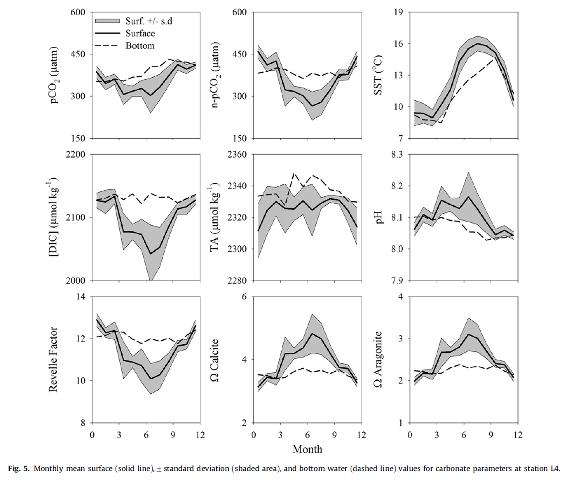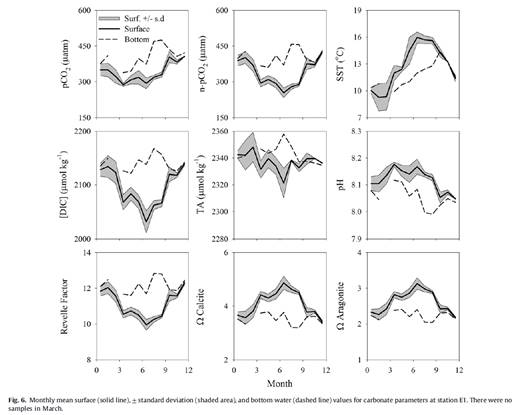Carbonate chemistry
L4 site
Dissolved inorganic carbon (CT) and total alkalinity (AT) measurements are sampled weekly (weather-dependent) at station L4, Western Channel Observatory, and analysed here at Plymouth Marine Laboratory. Since 2008 water has been collected in duplicate from the surface and near bottom niskins, and from 2018 onwards additional samples have been collected from 10 m and 25 m niskins. Water is collected using standard methods (Dickson et al. 2007). Measurements were initially collected by PML for the DEFRApH project (2008-2010) and now continue as part of NERC National Capability time-series monitoring at the Western Channel Observatory.
CT is measured using a Dissolved Inorganic Carbon Analyser (Apollo SciTech, Model AS-C3). The analyser adds a strong acid (10% H3PO4 plus 10% NaCl solution) causing carbon species within the seawater to be converted to CO2 gas, which is purged from the sample by pure nitrogen carrier gas, is dried and cooled to reduce water vapour. The concentration of the dried CO2 gas is measured with a LICOR LI-7000 CO2 analyser. The total amount of CO2 is quantified as the integrated area under the concentration-time curve, and converted to CT using a standard curve created by analysing known concentrations of the Certified Reference Materials (Dickson CO2 CRMs). AT is measured using the open-cell potentiometric titration method (Dickson et al. 2007) using an automated titrator (Apollo SciTech Alkalinity Titrator Model AS-ALK2). Calibration is made using Certified Reference Materials (Dickson CO2 CRMs). The group also participates in the QUASIMEME programme of proficiency testing.
These measurements, together with temperature, salinity, total phosphate and silicate, can then be used to calculate additional carbonate system parameters (pH, pCO2, saturation states of calcite and aragonite, HCO3- and CO32-). In addition, pCO2 and pH measurements are made using sensors onboard the Quest and the L4 mooring.
To use these data please contact Helen Findlay (hefi@pml.ac.uk). Data are also available from BODC
Cummings D; Dashfield S; Nunes J; Brown I; Fishwick J; Findlay HS (2015). Inorganic carbon and total alkalinity at the Western Channel Observatory from the L4 site from 2008 to 2014. British Oceanographic Data Centre - Natural Environment Research Council, UK. doi:10.5285/1ec0cae5-071d-16e1-e053-6c86abc07d47
The carbonate system shows a seasonal cycle at L4 which is driven by a combination of temperate and biological activity. This has been explored in detail in Kitidis et al. 2012 and is shown in the figure below.

E1 site
Dissolved inorganic carbon (CT) and total alkalinity (AT) measurements are sampled bi-monthly (weather-dependent) at station E1, Western Channel Observatory, and analysed here at Plymouth Marine Laboratory. Since 2008 water has been collected in duplicate from the surface and near bottom niskins. Water is collected using standard methods (Dickson et al. 2007). Measurements were initially collected by PML for the DEFRApH project (2008-2010) and now continue as part of NERC National Capability time-series monitoring at the Western Channel Observatory.
CT is measured using a Dissolved Inorganic Carbon Analyser (Apollo SciTech, Model AS-C3). The analyser adds a strong acid (10% H3PO4 plus 10% NaCl solution) causing carbon species within the seawater to be converted to CO2 gas, which is purged from the sample by pure nitrogen carrier gas, is dried and cooled to reduce water vapour. The concentration of the dried CO2 gas is measured with a LICOR LI-7000 CO2 analyser. The total amount of CO2 is quantified as the integrated area under the concentration-time curve, and converted to CT using a standard curve created by analysing known concentrations of the Certified Reference Materials (Dickson CO2 CRMs). AT is measured using the open-cell potentiometric titration method (Dickson et al. 2007) using an automated titrator (Apollo SciTech Alkalinity Titrator Model AS-ALK2). Calibration is made using Certified Reference Materials (Dickson CO2 CRMs). The group also participates in the QUASIMEME programme of proficiency testing.
These measurements, together with temperature, salinity, total phosphate and silicate, can then be used to calculate additional carbonate system parameters (pH, pCO2, saturation states of calcite and aragonite, HCO3- and CO32-).
To use these data please contact Helen Findlay (hefi@pml.ac.uk). Data are also available from BODC
Findlay HS; Cummings D; Dashfield S; Nunes J; Brown I; Fishwick J (2017). Inorganic carbon and total alkalinity at Western Channel Observatory station E1 (2010 - 2014). British Oceanographic Data Centre - Natural Environment Research Council, UK. doi:10.5285/50bb1181-960e-58b4-e053-6c86abc0e44f
The carbonate system shows a seasonal cycle at E1 which is driven by a combination of temperate and biological activity. This has been explored in detail in Kitidis et al. 2012, and is shown in the figure below.

 Western Channel Observatory
Western Channel Observatory